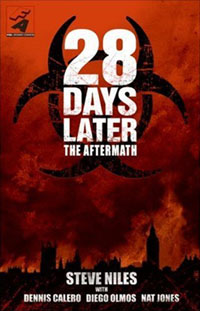BY KEVIN CARR
 Back in 2003, I praised the film “28 Days Later” for taking the tired, traditional zombie movie into new territory. Sure, director Danny Boyle has gone on record saying that “28 Days Later” is not a zombie film. And in fact, I agree with him, but in principal, I do not. They may not be the walking dead, but they sure act like zombies.
Back in 2003, I praised the film “28 Days Later” for taking the tired, traditional zombie movie into new territory. Sure, director Danny Boyle has gone on record saying that “28 Days Later” is not a zombie film. And in fact, I agree with him, but in principal, I do not. They may not be the walking dead, but they sure act like zombies.
For me, this was a huge improvement that zombie maven George A. Romero rejects. I found fast-moving zombies fascinating. There’s no doubt that “28 Days Later” left an indelible impact on the horror genre. Now, these more frisky zombies are more prevalent than the lumbering monsters of yesteryear. Simple put, they make great cinema.
The upcoming release of “28 Weeks Later” is something I am looking forward to with great anticipation. To help quench fans’ thirst for more rage stories, Fox Atomic has released the graphic novel “28 Days Later: The Aftermath,” written by Steve Niles with art by Dennis Calero, Diego Olmos and Nat Jones.
This is a fine bridge between the two movies. Not only does it show the origin of the rage virus (a story that was cleverly left untold in “28 Days Later”), but it fills in the gaps of time when our hero Jim (Cillian Murphy) was asleep in the hospital.
Comic books serve an essential role in genre films. They are often visionary, but not always ripe with good writing. When they work, they work well, and these products often serve as an excellent means to elaborate on what you don’t see in the films.
Taken as a graphic novel alone, “28 Days Later: The Aftermath” tells an interesting series of stories in London leading up to and during the aftermath of the rage virus. It’s a companion piece to the movies, and it’s a great bridge.
This graphic tie-in to “28 Days Later” isn’t the first time Fox has used the comic book medium to bolster its films. I remember the studio’s deft use of comic books to tell further stories of characters in the Star Wars universe back in the 1970s. Plus, they’re making a load of dough on recent comic book adaptations, including “The Fantastic Four,” “X-Men” and even lesser heroes like “Daredevil.”
Earlier this year, Fox released the big screen adaptation of the Dark Horse graphic novel “Pathfinder,” which took a far less traditional and far more artistic approach to comics than “28 Days Later: The Aftermath.”
Laeta Kalogridis and Christopher Shy’s “Pathfinder” tells the story of a Viking child left for dead after a raid on Native American villages. Set 500 years before Christopher Columbus came to the New World, this story is an homage to the Tarzan legends. The child, known as Ghost for his white skin, grows to be quite a warrior. When the Vikings return and wipe out his village, Ghost goes on a rampage to destroy the Norsemen.
The graphic novel “Pathfinder” isn’t as much a traditional story as a tapestry of pop culture art. It uses the comic book medium to tell an epic story. Not the standard ink-and-pencil art, “Pathfinder” uses watercolors and dark photorealism to tell its story.
“Pathfinder” comes with an extensive introduction written by film director Marcus Nispel, explaining the origins of the project, including how he wanted to extend the portrayal of the Vikings as surreal monsters. While film is a visual medium, the comic book is even more so. Pages of a comic book can extend into hyper-reality even beyond what Hollywood can achieve on screen.
Comic book fans should be thrilled because we are in the golden age of comic book films. With the “Spider-Man,” “X-Men” and “Batman” series setting the bars for superheroes, and with “Sin City” and “300” proving that frame-by-frame accurate adaptations are not just possible but profitable, the world of cinema has finally caught up with the comic book vision.
Movie tie-ins, stand-alone graphic novels and visionary works of art just the beginning. It’s an exciting time for a geek like me.
